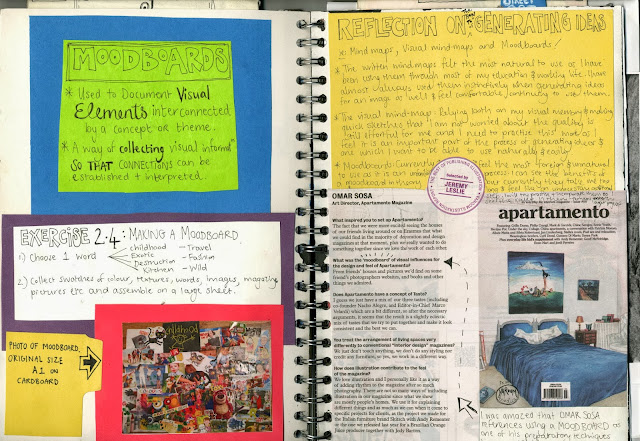Exercise 2.3: Turning Words into pictures
Brief: Choose a word from the list below and draw a visual brainstorm of anything that comes to mind:
Childhood; Exotic; Destruction; Kitchen; Wild; Fashion; Travel. The drawings are to act as a visual shorthand therefore accuracy is secondary.
Comment on the mental processes undertaken to generate drawings.
I chose TRAVEL and tried to draw everything from memory instead of using any external references to prevent being caught up focusing on the accuracy of the drawings.
Relying on my visual memory proved to be a HUGE challenge! Trying to look into my minds eye and link that with my motor skills to come up with an image was so much harder then I hoped!.....as the suitcase among other symbols demonstrate!
I initially kept the drawings in black and white but soon added colour using pencil crayons as the colour actually helped me to evoke memories and ideas.
The swatches of colour had a way of speaking volumes on their own and I found that colour in itself helped to illustrate abstract concepts more easily and effectively then a specific graphic symbol. For example: the yellow on it's own denotes heat, summer, holiday, relax, sunshine, exotic, far away and so on. When drawing symbols I stuck to objects mostly as they were easier to think of.
Because of my struggle with accessing my own visual memory I decided to use the internet for a few definitions to help me out:
1). visual memory:
the ability to create an eidetic image of past visual experiences
1a). eidetic: /ei·det·ic/ (i-det´ik) denoting exact visualization of events or objects previously seen;
Etymology: Gk, eidos, a form or shape seen
1 adj, pertaining to or characterized by the ability to visualize and reproduce accurately the image of objects or events previously seen or imagined.
http://medical-dictionary.thefreedictionary.com/visual+memory
2).Visual memory describes the relationship between perceptual processing and the encoding, storage and retrieval of the resulting neural representations. Visual memory occurs over a broad time range spanning from eye movements to years in order to visually navigate to a previously visited location.
http://en.wikipedia.org/wiki/Visual_memory
I recognise that being able to access one's visual memory as an artist is an essential skill. Illustrators will often not have a visual reference to draw from or may have to manipulate a character or scene to work with the given brief. Manipulating images in ones visual memory is essential for more imaginative drawing as well. It is my understanding (and hope) however, that being able to access your visual memory is a skill that can be improved with practice and habit. I have been assured that the more I draw the more I will increase my visual repertoire and the easier it will be to rely on a visual shorthand. I am hoping that the principle of 'practice makes perfect' will prevail.
What I did like about doing the exercise this way was that it forced me to come up with symplified symbols and graphic representations, some of which work and some which don't. I found that as I kept going I relaxed a little more and became less anxious about how accurate the drawings were.
To further improve on this exercise I would like to incorporate swatches of texture as it has a way of evoking memories and adding a new dimension to an image and to improve my visual memory I guess I'd better draw! draw! draw!















